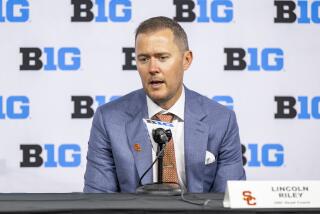Hats off to ‘Bama’s ‘Bear’
- Share via
PAUL William “Bear” Bryant died 23 years ago, but the shadow he cast on college football seems to grow longer with each passing season. Thanks to depictions in films (“Forrest Gump”) and in television movies (“The Junction Boys”), his trademark houndstooth hat is perhaps as familiar to football fans all over the country now as when Bryant was alive. Because Bryant’s career touched on so many issues -- alleged betting scandals, the integration of college sports, the boom of televised college football -- literature about Bryant is becoming a light industry, producing more books than he could have had time to read in his 38 years as head coach at Maryland, Kentucky, Texas A&M; and, of course, Alabama.
Most books on Bryant’s life and career focus on his unmatched record of six national titles at Alabama, but two new books have found great stories in years when Bryant’s Crimson Tide didn’t win.
Keith Dunnavant’s “The Missing Ring” recalls the legendary 1966 season, when the Bear’s Tide was gunning for its third straight national championship -- yes, Trojan fans, the 2005 USC team wasn’t the first to make that run -- and failed in perhaps the most controversial season finish the college game has ever seen.
The other contenders for the title that year were Ara Parseghian’s Notre Dame Fighting Irish and Duffy Daugherty’s Michigan State Spartans. After Notre Dame and MSU played to a 10-10 tie, with Parseghian choosing to have his quarterback run out the clock on the last play rather than chance an interception, the undefeated Alabama team was still ranked third in the Associated Press and United Press International polls. Alabama, Dunnavant thinks, was shafted because the Crimson Tide was still fielding an all-white team.
1966 was perhaps the pivotal year in college football history, the year when, in addition to integration, the power of the sport as a TV draw became evident (ratings for the late-season clash between the No. 1-ranked Irish and the No. 2 Spartans exceeded those for the first Super Bowl two months later). There’s a great book to be written on that season, but Dunnavant instead has chosen to air a grudge.
There is certainly some evidence for arguing that the Alabama football team was a victim of politics. A vocal minority, led by the Los Angeles Times’ Jim Murray (who accused Bryant and Alabama of playing for the “Magnolia Championship”), made it obvious that no segregated team would get their vote. Dunnavant’s case for the ’66 Tide, though, is based far more on emotion than logic, and some of that emotion is borderline irrational. By choosing to let the voters decide rather than risking a loss on the final play against Michigan State, writes Dunnavant, “Parseghian deftly exploited the media’s love affair with the Irish and the widespread anti-Southern bias working against the Crimson Tide.” What “bias”? The UPI poll was conducted among coaches, not writers like the AP poll, and his fellow coaches certainly had no bias against Bryant or Alabama. In any event, all-white teams from the South -- including Auburn, Louisiana State, Texas and Alabama three times -- had won six of the nine championships from 1957 through 1965, and in 1969, Texas, still all-white, would win again, a fact of which Dunnavant seems unaware.
Furthermore, there is no compelling reason why Notre Dame’s ’66 squad shouldn’t have won it all; they played a tougher schedule than either Alabama or Michigan State and won by a wider margin of victory. Even if Parseghian erred in being overly cautious, why should his team have been punished?
Myself, I’d have voted for Alabama, but as I grew up there, I’m not objective. But when Dunnavant declared that the vote for Notre Dame was “the greatest misjustice in college football history,” my jaw dropped. The greatest misjustice in college football history is that so many black players from Alabama and the rest of the South weren’t given their chance to play in their home states. And, frankly, I don’t share Dunnavant’s optimism as to how much progress the state has made because Condoleezza Rice made the toin-coss to open the 2005 Alabama-Tennessee game in Tuscaloosa. I’d feel better if I knew for sure there were more blacks in the stands that day than on the field.
The game that accelerated the process of integration in Southern football is recounted in vivid detail by Don Yaeger in “Turning of the Tide.” By the end of the 1960s, Bear Bryant felt that he had built up sufficient leverage to defy Gov. George Wallace’s segregationist stance, as well as obstructionist sentiments within his own university, and was ready to recruit top black athletes. The problem was that the top black athletes didn’t want to play for Alabama. Looking for a dramatic stage from which to send a message that his team was ready to integrate, Bryant contacted his good friend, USC coach John McKay, and, over drinks, shook hands on a deal: USC would open the 1970 season in Birmingham, and ‘Bama would return the favor in ’71 at the Los Angeles Coliseum.
Yaeger doesn’t pretend to completely understand the motives of the inscrutable Bryant, who never made clear his reasons for arranging the match, aside from the purely financial. In retrospect, though, it’s clear that the Bear’s intentions were to shake up the boosters and politicians who still resisted integration and that Bryant also knew his team was no match for the Trojans. It was not, as it would later be described, the first time Alabama played an integrated team in the state. But because it was USC, a school with a history as storied as Alabama’s, the 42-21 Trojan rout was the game that caught the attention of the entire South.
The Alabama papers, white and black, made no mention of the significance of the game, but word of mouth made all the difference. Even before the game, Jim Murray understood the result no matter who won: “The point of the game will not be the score, the Bear, the Trojans; the point of the game will be Reason, Democracy, Hope. The real winner will be the South.”
Murray was right, and “Turning of the Tide” is that rare sports book that can be read with pride by fans of both the winning and losing teams. I only wish Yaeger had devoted more space to the next season’s game, when an integrated Alabama team whipped USC in Los Angeles. To his credit, Yaeger doesn’t seem to believe the legend that after the game Bryant brought USC’s black fullback Sam “Bam” Cunningham (who had rushed for 135 yards) to the Tide locker room, where he told his players, “Gentlemen, this is what a football player looks like.” It never happened.
But I’ll bet that scene shows up when they make the movie.
*
Allen Barra is the author of “The Last Coach: A Life of Paul ‘Bear’ Bryant.”
More to Read
Go beyond the scoreboard
Get the latest on L.A.'s teams in the daily Sports Report newsletter.
You may occasionally receive promotional content from the Los Angeles Times.










